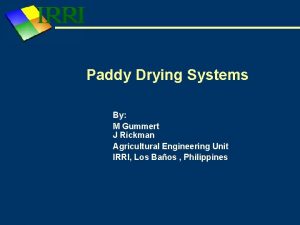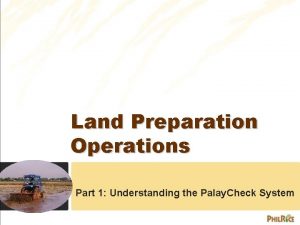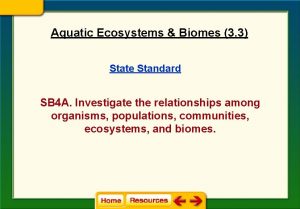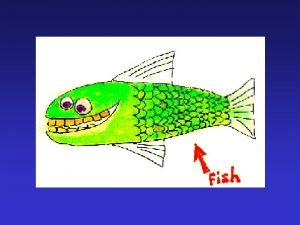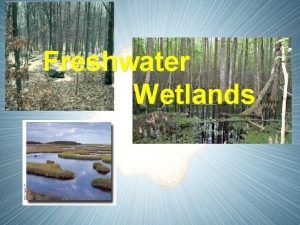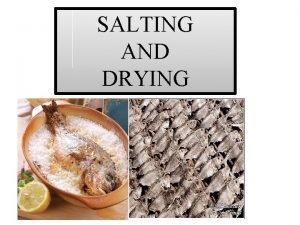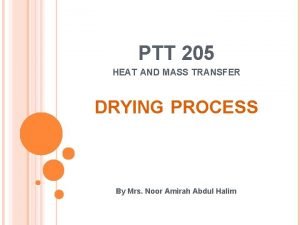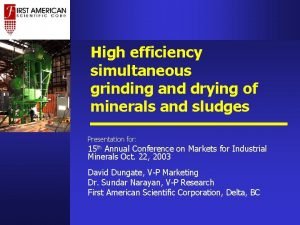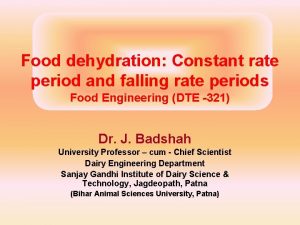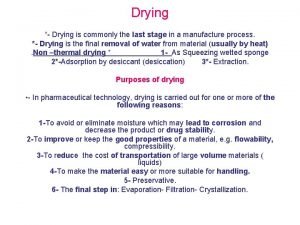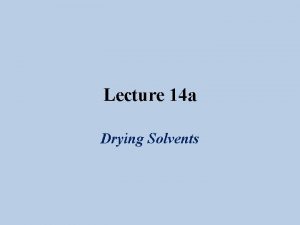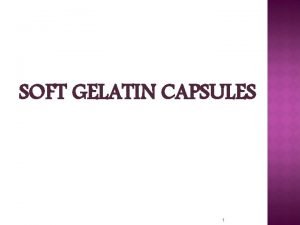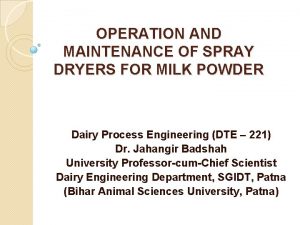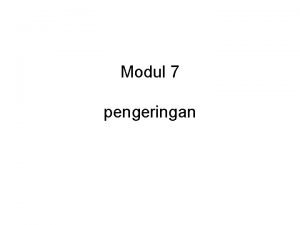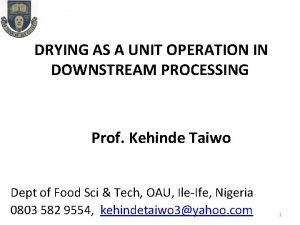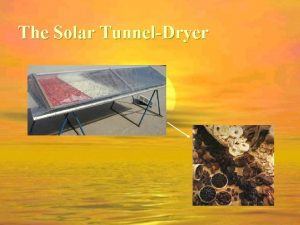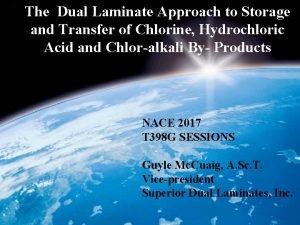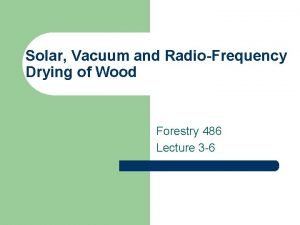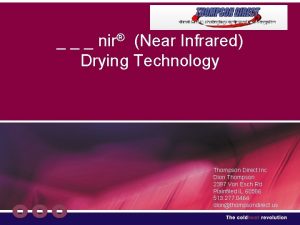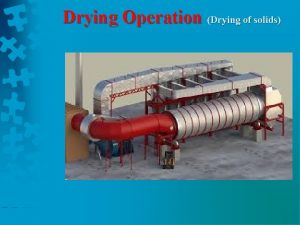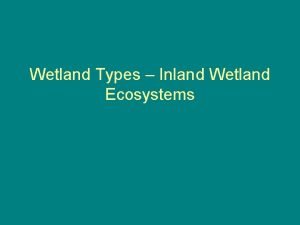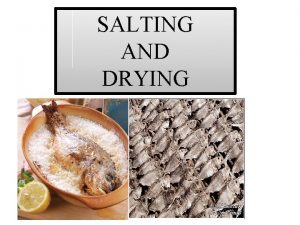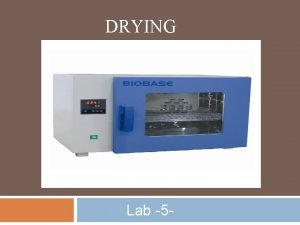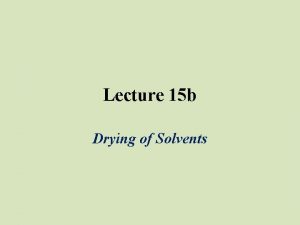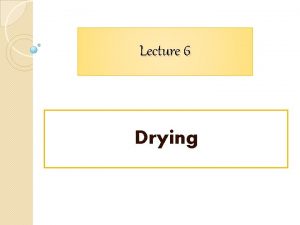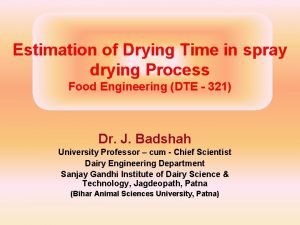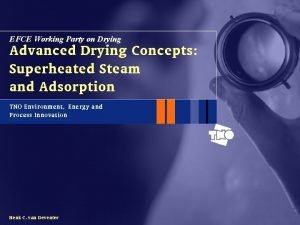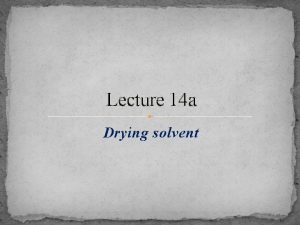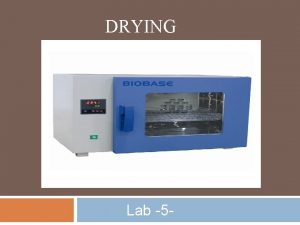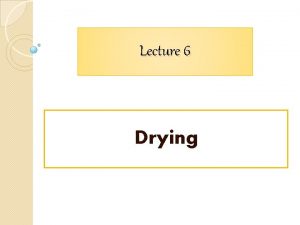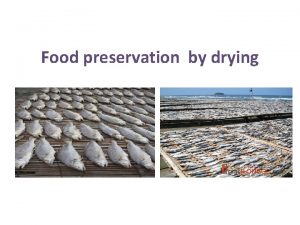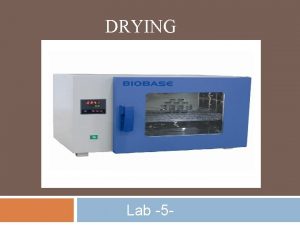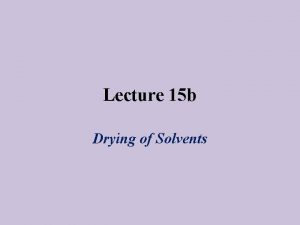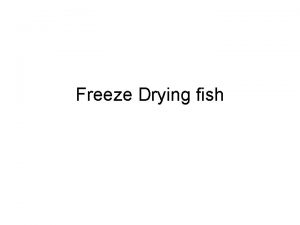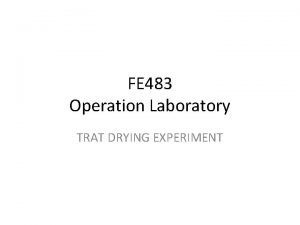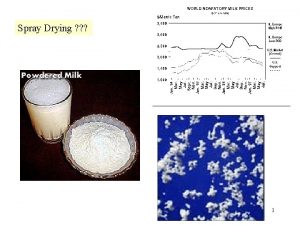Drying and wetland community structure Outline Wetland properties



























- Slides: 27

Drying and wetland community structure Outline: • Wetland properties • Strategies for drying habitats • Trade-offs and community assembly 1 December 2009 Hamish Greig hamish. greig@ubc. ca

What is a wetland - a legal nightmare! • “ An ecosystem that arises when water inundation produces soils dominated by anaerobic processes, and forces the biota. . . [esp plants]. . . to exhibit adaptations to tolerate flooding” (Keddy 2000) • Shallow < 2 m lentic habitats characterised by high productivity in benthic and pelagic zones

Wetland drying: fundamental community filter Hydroperiod: schedule of filling and drying Wet phase Drying phase Consists of: 1. 2. 3. 4. 5. Permanence: i. e. permanent, semi-permanent, temporary Phenology: seasonal timing of drying and filling Duration of dry and wet phases Harshness during both phases Predictability of drying and filling

Hydroperiods vary between habitats Frozen Wissinger chapt 41

How do aquatic organisms deal with drying? Sweet! No bug picking %$&^@*

1) Desiccation resistant stages • Egg banks e. g. , water fleas (Cladocera) Good conditions: produce parthenogenetic eggs seed shrimp (Ostracoda) Deteriorating conditions : produce “epphipia” eggs copepods (Copepoda) fairy shrimp (Anostraca)

1) Desiccation resistant stages cont. • Insects also have desiccation resistant eggs – Oviposit inside plant stems, e. g. , damselflies – Gelatinous coatings, e. g. caddisflies • Juvenile and adults stages can also resist drying Worms Some molluscs Some dragonflies Even some fish e. g. , Canterbury mudfish

2) Rapid development and recolonisation • Develop and emerge before drying – often multiple generations • Requires terrestrial stages – complex life cycles = metamorphosis across habitats Mosquitoes (7 – 10 days) Midges (10 – 14 days) days after filling Mayflies (~ 30 days) weeks after filling Odonates (30 – 60 days)

3) Migrating aquatic adults • Some aquatic adults move between permanent and temporary ponds = cyclic colonisation Beetles (Coleoptera) Waterstriders Waterboatmen Waterbugs (Hemiptera) Backswimmers Permanent ponds after drying after filling Temporary ponds Wissinger 1997

4) Synchronized life histories • Combines desiccation resistance, phenology and diapause in complex life cycles • Very synchronous larval development % in each instar e. g. Asynarchus caddisflies in vernal ponds

New Zealand lentic habitats

Community patterns in NZ ponds Ordination axis 2 Vernal Autumnal Permanent • Community shift across hydroperiod gradient • Intermediate community type in autumnal ponds • Taxa with adaptations to drying dominate temporary ponds Ordination axis 1 60 Rapid Colonizers % Biomass (AFDM m-2) 50 40 Desiccation Tolerant 30 20 Aquatic Adults Permanent Only 10 Perm Temp Odonates Perm Temp Caddis Perm Temp Mollusca Perm Temp Annelids Perm Temp Microcrust. Benthic Invertebrate Taxa Perm Temp Beetles Perm Temp Water Bugs Perm Temp Diptera Wissinger et al. 2009

Influence on community structure Predator-permanence model of community assembly Drying stress Vernal Autumnal Fishless perm Pond permanence gradient Modified from Wellborn et al. 1996 Perm w fish

Top predators also change with permanence Permanent Cyprinid minnows Centrarchiids (Bass) Salamander larvae Beetles Trout Autumnal/ Large beetles (Dytiscus) Semi-permanent Dragonflies Damselflies Vernal Cannibals/ facultative preds Backswimmers Small beetles (e. g. , Rhantus)

Predator-permanence model of community assembly Predator gradient Influence on community structure Small beetles & hemipterans Beetles & Odonates Salamanders & large inverts Predation Drying stress Vernal Autumnal Fishless perm Pond permanence gradient Modified from Wellborn et al. 1996 Fish Perm w fish

Trade-offs in alpine caddisflies Trade-offs between growth and predation risk lead to species replacements Wissinger et al. 1996, 1999, 2004 a, b, 2006

Microcosms for behaviour In-situ cages w natural prey communities Mesocosms for predation trials Other ‘experiments’

Trade-offs in Limnephilid caddisflies Lessons from 10 years of research! Desiccation resistant eggs Asynarchus nigriculus • • • Limnephilus picturatus Frantic foraging Cannibalism Intraguild predators Small cases No predator escape behaviour Rapid development but vulnerable to predators Limnephilus externus • • Agrypnia deflata Slow foraging Not aggressive Bulky cases Efficient escape behaviour Slow development but avoids predation

Wissinger et al. 2006 Realised niche Occasional presence IGP/Cannibals Excluded Vernal Beetles Salamanders Autumnal Permanent Asynarchus L. picturatus L. externus Agrypnia 1 cm Trade-offs between growth and predation risk lead to species replacements

Temp vs. Perm w/ vs. w/o Taxon Common name Hydroperiod Predators Porifera Sponges x Turbellaria Flatworms x Nematoda Roundworms x Rotifera Rotifers x Bivalvia Clams x x Gastropoda Snails x x Hirundinea Leeches x x Oligochaeta Worms x Arachnida Mites x x Anostraca Fairy Shrimp x x Cladocera Water Fleas x x Conchostraca Clam Shrimp x Notostraca Tadpole Shrimp x Copepoda Copepods x Amphipoda Amphipods x x Decapoda Crayfish, Shrimp x Isopoda Isopods x Ostracoda Seed Shrimp x Anisoptera Dragonflies x x Coleoptera Beetles x x Diptera True Flies x x Ephemeroptera Mayflies x Hemiptera True Bugs x x Megaloptera Alderflies x Trichoptera Caddisflies x x Zygoptera Damselflies x x __________________________ Species replacements in nearly all lentic taxa Other well described species replacements: 1) Lestes and Enallagma damselflies (Stoks & Mc. Peek 2006) 2) Freshwater amphipods (Wellborn 2002) Wellborn et al. 1996

Community patterns across permanence gradient Harsh biotic conditions Species richness Harsh aboitic conditions Vernal Autumnal Permanence gradient Species replacements Permanent

Species Permanence gradient V V V 1 1 V V P 1 1 1 1 1 1 1 1 1 1 1 1 1 1 1 1 1 1 P 1 1 1 1 A 1 1 1 1 1 1 1 1 1 1 1 1 1 1 1 1 1 1 1 1 1 • Shifts in species richness and composition 1 1 1 1 Replacements and community composition 1 1 1 • More species in perms – Larger habitats (species-area effect) – No drying constraints 1 1 1 1 1 1 • Different species in temps vs perms = species replacements 1 1 1 1 14 sp. not in perms 1 1 Data from Urban 2004

Species replacements vs. nested subsets Harsh biotic conditions Species richness Harsh aboitic conditions Vernal Autumnal Permanence gradient Species replacements Nested subsets Permanent Fish

Variation in community patterns between regions Temporary pond specialists Permanent pond specialists Generalists Utah desert Cass, Canterbury 52% Jocque et al 2007 Aseasonal rainfall Colorado Rockies 47% 58% Greig 2009 Seasonal rainfall New England 33% Wissinger et al 1999 Urban 2004 Seasonal snowmelt

Testing hypothesis needs replication at a global scale • Compare community patterns across perm gradients – Ponds cluster = replicate species pool • Response variables – Nestedness – % generalists • Predictors – Seasonal predictability of rainfall & runoff – Top predator type

Why do we care? Drying regimes are affected by climate shifts Arctic ponds drying for the first time in millennia!

Suggested reading Wissinger, S. A. 1999. Ecology of wetland invertebrates: synthesis and applications for conservation and management. Pages 1043 -1086 in D. P. Batzer, R. B. Rader, and S. A. Wissinger, editors. Invertebrates in freshwater wetlands of North America. Willey, New York. Focus on 1052 -1065 PDF at http: //webpub. allegheny. edu/employee/s/swissing/Books_pdf/Invertebrates_Chapter 41. pdf Wellborn, G. A. , D. K. Skelly, and E. E. Werner. 1996. Mechanisms creating community structure across a freshwater habitat gradient. Annual Review of Ecology and Systematics 27: 337 -364. Additional references Jocque, M. , T. Graham, and L. Brendonck. 2007. Local structuring factors of invertebrate communities in ephemeral freshwater rock pools and the influence of more permanent water bodies in the region. Hydrobiologia 592: 271 -280. Keddy, P. A. 2000, Wetland Ecology. Principles and Conservation. Cambridge Univ. Press, Cambridge , UK. Stoks, R. , and M. A. Mc. Peek. 2006. A tale of two diversifications: reciprocal habitat shifts to fill ecological space along the pond permanence gradient. American Naturalist 168: S 50 -S 72. Urban, M. C. 2004. Disturbance heterogeneity determines freshwater metacommunity structure. Ecology 85: 2971 -2978. Wellborn, G. A. 2002. Trade-off between competitive ability and antipredator adaptation in a freshwater amphipod species complex. Ecology 83: 129 -136. Werner, E. E. , and M. A. Mc. Peek. 1994. Direct and indirect effects of predators on 2 anuran species along an environmental gradient. Ecology 75: 1368 -1382. Wissinger, S. A. 1997. Cyclic colonization in predictably ephemeral habitats: a template for biological control in annual crop systems. Biological Control 10: 4 -15. Wissinger, S. A. , J. Steinmetz, J. S. Alexander, and W. Brown. 2004. Larval cannibalism, time constraints, and adult fitness in caddisflies that inhabit temporary wetlands. Oecologia 138: 39 -47. Wissinger, S. A. , J. C. Whissel, C. Eldermire, and W. S. Brown. 2006. Predator defense along a permanence gradient: roles of case structure, behavior, and developmental phenology in caddisflies. Oecologia 147: 667 -678. Wissinger, S. A. , H. H. Whiteman, G. B. Sparks, G. L. Rouse, and W. S. Brown. 1999. Foraging trade-offs along a predatorpermanence gradient in subalpine wetlands. Ecology 80: 2102 -2116. Wissinger, S. A. , H. S. Greig, and A. R. Mc. Intosh. 2009. Absence of species replacements between permanent and temporary lentic habitats in New Zealand. Journal of the North American Benthological Society 28: 12 -23.
 Panicle drying advantages
Panicle drying advantages Use in wet and dry land preparation
Use in wet and dry land preparation Wetland dominated by nonwoody plants
Wetland dominated by nonwoody plants Submerged gravel wetland
Submerged gravel wetland What does a wetland do for the environment
What does a wetland do for the environment Inland wetland
Inland wetland Wetland ecosystem definition
Wetland ecosystem definition Salting and drying
Salting and drying Difference between drying and evaporation
Difference between drying and evaporation Kds micronex
Kds micronex Falling rate period
Falling rate period Disadvantages of freeze drying
Disadvantages of freeze drying Examples of quote sandwiches
Examples of quote sandwiches Saponification value
Saponification value Freeze drying solvents
Freeze drying solvents Drying time formula
Drying time formula Soft gelatin capsule
Soft gelatin capsule Dairy spray dryers
Dairy spray dryers Cross circulation drying
Cross circulation drying Drying in downstream processing
Drying in downstream processing Solar tunnel dryer for drying coconuts
Solar tunnel dryer for drying coconuts Duel laminate tanks
Duel laminate tanks 4 stages of clay
4 stages of clay Rf vacuum timber drying kiln
Rf vacuum timber drying kiln Is chopping wood a chemical change
Is chopping wood a chemical change Drying technology
Drying technology The three subdivisions of the small intestine are ________.
The three subdivisions of the small intestine are ________. Lyophilization process steps
Lyophilization process steps
